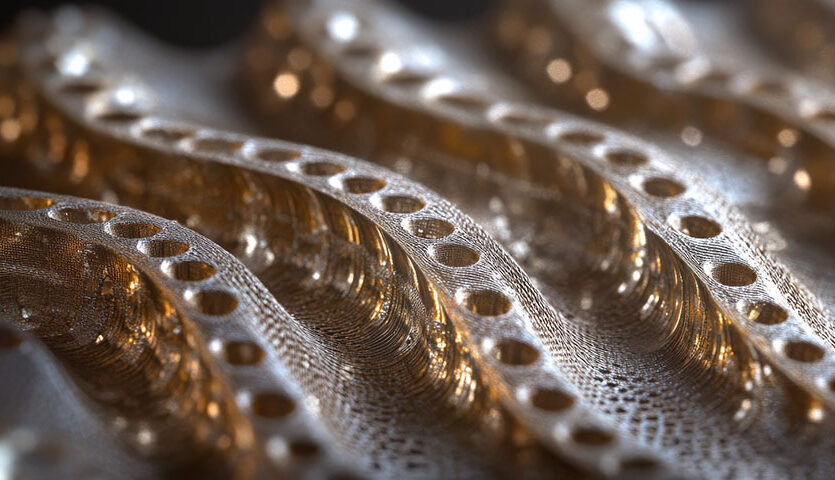S.H.A.D.E.
Stealth High-temperature Advanced Defense Engineering
S.H.A.D.E. is our groundbreaking metamaterial technology engineered for stealth in extreme environments. It merges advanced nano-engineering with state-of-the-art composite systems to deliver unparalleled radar absorption, exceptional thermal resilience, and robust structural integrity under ultra-high temperatures. Designed for mission-critical aerospace and defense applications, S.H.A.D.E. redefines performance by ensuring low detectability and superior durability in the harshest conditions.
Key Benefits
- Unmatched Radar Absorption:
By employing a multilayer design that integrates photopolymer stealth resins with printed Split-Ring Resonators (SRRs), S.H.A.D.E. achieves near-total (up to 99%) absorption of radar signals across a broad frequency spectrum—from VHF to Ku bands—drastically reducing Radar Cross Section (RCS). - Extreme Thermal Resilience:
The technology is engineered to withstand ultra-high temperatures, making it suitable for applications in high-speed aerospace and defense vehicles. The composite formulation, enriched with high-temperature nanofillers, ensures stability even under extreme thermal loads. - Superior Structural Integrity:
S.H.A.D.E. is built on a carefully optimized, layered architecture that combines a UV-curable stealth resin matrix with advanced nano-additives (including ferrites, carbon nanotubes, and graphene) and strategically printed SRRs. This results in a lightweight yet mechanically robust material that maintains its stealth performance over time. - Versatile Integration:
The coating is designed to be applied on a variety of high-performance structural materials (XHT) such as carbon fiber composites, advanced metal alloys, and other aerospace-grade substrates. Its ultra-thin, conformable nature (with a total thickness as low as 2.4–3 mm for the full multilayer system) ensures minimal impact on weight and aerodynamics.
Technical Overview
Material Composition
S.H.A.D.E. is formulated using a photopolymer stealth resin that serves as the binder, which is loaded with a precise blend of nano-additives:
- Ferrite Nanoparticles (e.g., NiZnFe₂O₄):
Enhances the magnetic permeability and increases absorption of incident radar waves. - Carbon Nanotubes (CNTs) and Graphene:
Improve electrical conductivity and thermal dissipation, thereby lowering residual reflections. - Barium Titanate (BaTiO₃):
Elevates the effective dielectric constant, facilitating a smooth impedance gradient across layers.
Engineered SRR Integration
- Split-Ring Resonators (SRRs):
Printed directly onto each cured resin layer using advanced lithography or inkjet printing, SRRs are designed in fractal or multi-scale geometries to target specific radar bands. Their precise dimensions are optimized based on target frequencies, ensuring resonance and energy dissipation across a wide spectrum.
Multilayer Architecture
- Layer Structure:
The coating is assembled layer-by-layer with alternating stealth resin and SRR patterns. Typically, 8–12 layers are applied, resulting in a total thickness of approximately 2.4–3 mm. This graded multilayer configuration creates a continuous impedance transition from the coated object to free space, drastically minimizing reflections. - High-Temperature Stability:
The resin is specifically formulated for high-temperature resistance (up to 200°C or more), and the nano-additives further reinforce the material’s stability under thermal stress.
Manufacturing Process – PREDICT-M Inspired
- Deposition & UV Curing:
A thin layer of the stealth resin is uniformly applied to the substrate and cured under UV light, forming a robust base. - SRR Printing:
Using high-resolution lithography or inkjet printing, conductive SRR patterns are deposited directly on the cured resin. These patterns are precisely engineered to resonate at desired radar frequencies. - Layer-by-Layer Assembly:
Additional resin layers are applied over the printed SRRs, and the process is repeated until the desired multilayer structure is achieved. Each successive layer is designed with slight variations in nano-additive concentrations to fine-tune the impedance gradient. - Final Protective Coating:
A thin, durable overcoat is applied to protect the stealth properties against environmental factors such as moisture, abrasion, and UV degradation.
Conclusion
S.H.A.D.E. represents a paradigm shift in stealth technology, integrating advanced nano-engineered metamaterials into a high-temperature, structurally robust, and ultra-thin coating. Its unique multilayer architecture and precision-engineered SRRs ensure near-total radar absorption (approaching 99%), making it ideally suited for next‑generation aerospace and defense applications where low observability and high performance are critical.
Discover S.H.A.D.E. – where stealth meets resilience, and performance defies the extremes.
• Reinventy Solutions is not responsible for comments, interpretations or re‑use made by third parties.
• All specifications are preliminary and may change without notice; shared links should therefore cite the original URL.
• This limited permission does not convey any licence to our trademarks, images or technical data beyond the context of the original page.
See the full Master Technology & Commercial Disclaimer .
Metatmaterials
Nano-composite integration



